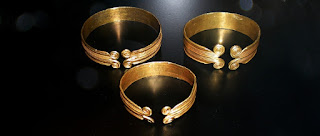Already heard about.....?
European lake monsters – 1. series
Loch
Ness Monster is not the only one lake monster in the world, nor in Europe. One
her relative named Storsjöodjuret, which is probably most famous Sweden
monster, can be find in lake Storsjön near city Sandviken. Storsjöodjuret with long snake body and
tongue, large dark eyes, shiny skin, powerful tail, several humps and two pair
of legs or fins was officialy for first
time observed in 17th century.
Some
of them mention also George M. Eberhart, who stated „Around 1839, Aron Andersson and others at
Hackås watched a red-gray animal with a head like a horse´s and
a white mane swimming away from the shore. Marta and Karin Olsson were washing
clothes on the beach near Sörbyn on October 13, 1893, when they saw an animal´s
head rising and falling in the water. After Karin threw some stones at it, it
swam swiftly toward the shore. The women ran but saw the animal submerge
eventually.“
Even
there are more than 200 sightings, there are different description of creatures´
head. Some of witnesses said that it had horse, cat or dog like head.
Interesting thing is that many witnesses said, that it have also white mane. Also
because of this is often named as waterhorse.
Many
expeditions wanted to find relevant evide of existence, but none of them was
completely successful. Creature is most active in the summer but some sightings
were also in winter. Some people said that creatures migrate on winter and during
the summer are moving between various lakes, to which they can get also through
land, when they are using fins as legs. Researchers think that creatures are
moving in a pack.
In
17th century was placed on the Island in the middle of the lake protective rune
stone, where were engraved rune symbols and the most faihful image of creature.
As stated legend, which was written by Andreas Plantin: "It is said that beneath this (rune) stone lies a dreadfully large head of a serpent and that the body stretches over Storsjön to Knytta by and Hille Sand where the tail is buried. The serpent was called a ra and therefore shall this stone be risen. Since no one peacefully could cross (Storsjön). the ferryman and his wife states, along with many others, that in the last turbulent time this stone was tore down and broken in two. As long as this stone laid on the ground many strange things occured in the water, until the stone was risen and assembled anew."
Citations:
Jan-Ove Sundberg. Storsjoodjuret, Seljordsormen, Nessie och andra sjomonster. (Sodertalje: Larsons Forlag, 2002)
George M Eberhart. Mysterious Creatures. A guide to Cryptozoology. (Santa Barbara: ABC CLIO, 2002)
picture source https://pixabay.com/sk/photos/?q=Storsj%C3%B6n+&hp=&image_type=all&order=&cat=%28%27travel%27%2C+u%27Cestovanie%2FDovolenka%27%29&min_width=&min_height=
picture source https://pixabay.com/sk/photos/?q=Storsj%C3%B6n+&hp=&image_type=all&order=&cat=%28%27travel%27%2C+u%27Cestovanie%2FDovolenka%27%29&min_width=&min_height=



Comments
Post a Comment
Have you heard about that? / Do you have some personal story about that?